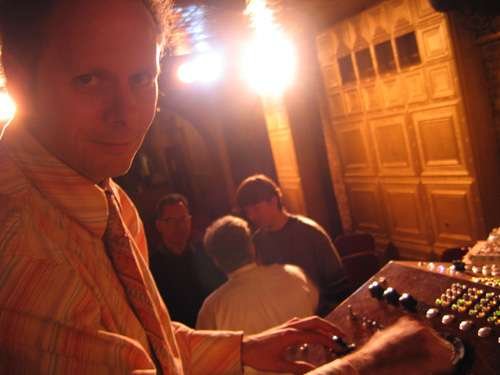"We set up gymnasiums that electrons kind of fling around in.
That's sort of how we're making sounds."
September 1, 2009
Leon and Brian Dewan are cousins who have invented, designed and built a family of electronic instruments, most of which are known collectively as "Dewanatrons." They perform on these instruments in various musical projects, including their own act, called Dewanatron. Leon was previously known as a singer, songwriter and guitar player in the indie rock band, The Happiest Guys In the World. Brian, who resides in Catskill, New York, has been a musician/performer and multimodal visual artist, with numerous solo and collaborative acts (go to his Wikipedia page for a full rundown). Artocratic interviewed the two of them at Leon's home, which also houses his experimental music laboratory, in New Rochelle, New York.
***Update: The Dewanatron Swarmatron has recently been featured quite extensively by Trent Reznor, of Nine Inch Nails, both in his new project How To Destroy Angels and in the soundtrack he created for the film The Social Network. ***Linda: Can you describe what you are up to with your band, Dewanatron?
Brian: One thing to know is that Dewanatron is sometimes a band and sometimes an art installation. The Pierogi Galleries (one in Brooklyn, New York and one in Leipzig, Germany) represent us and show our instruments as an art exhibit, and give us a space to perform in when we ask. In the case of live “band” concerts, it's just us two; although occasionally we're joined by guest musicians.

Leon Dewan
Leon: We just finished a CD in late 2008 called Semi-Automatic. We played a bunch of shows in 2008, in cities as far flung as Minneapolis and Saranac Lake, New York, which necessitated a lot of driving. We realized that we really need to be able to take our act in the air, so right now we're working on smaller, more modular, luggage-limit-friendly instruments so that we can play places like California and Europe.
Linda: How many different instruments belong to the Dewanatron family?
Leon: We’ve built about 35 of them. Each is handcrafted and unique, but they tend to fall into groups in terms of the sound they produce. 15 are called Wall Gins; we have a few Swarmatrons; we have a bunch of folk synthesizers; and then there's the utterly unique Dual Primate Console, and also the Hymnotron.
[The instruments are described and shown on their Web site: www.dewanatron.com]

Brian Dewan
Linda: Is your music located within a particular genre?
Leon: I guess it all lives in the territory of experimental electronic music that isn't pop electronica. We're taking up where people left off in the '50s and early '60s: people like Raymond Scott; a group called The Silver Apples in New York City – they were practically unknown back then, but in certain circles they were really famous because what they did was so weird and so ahead of its time. Some of their stuff was rhythmically very late-1990s or 2000s even though it was done in 1966; it was very experimental.
Brian: Raymond Scott was an experimenter in electronic music and instrument-making. He customized a theremin made by Robert Moog and his father in the '50s, and worked with an engineer in the '60s to create the Electronium, a "composing machine" synthesizer with which you would suggest a theme and it would permutate what you put in into something else. He was very secretive about these projects and worked in seclusion. He wasn't a conventional avant-gardist; having a background leading a swing band, he made some atonal electronic music with syncopated jazzy rhythms – something that avant-garde purists never did.
Brian: We have a fondness for that "golden age" of electronic music that does not fall back on preset sounds or patterns but has to be dished up "fresh.” But we're generally reverent about the whole long and venerable history of electronic music, starting with the first electric instrument, Elisha Gray's Musical Telegraph from the 1870s, and the first synthesizer, Thaddeus Cahill's ambitious Telharmonium, which he invented in the 1890s.
With the Dewanatrons, we use traditional synthesis techniques as well as new ones, but we're particularly drawn to the fluidity of unstandardized instruments and organic situations that intertwine control and indeterminacy. We admire the creativity of electronic artists like David Tudor or Louis and Bebe Barron because it thrived on setting up sprawling situations and seeing what would happen (quite antithetical to the pursuit of ever-more-precise control or standardization of equipment). I’d say that we fit in with the homegrown aspect of their approach, that made instrument-making a part of composing music.


